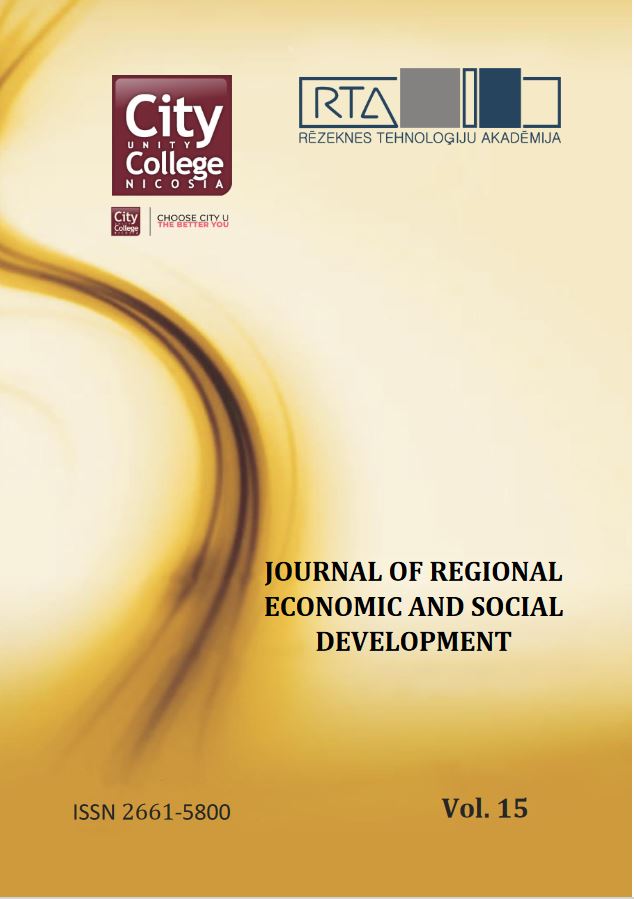ASSESSMENT OF THE GOVERNMENT FINANCIAL POLICY: SITUATION IN LATVIA
DOI:
https://doi.org/10.17770/jresd2023vol15.7379Keywords:
state financial policy, fiscal policy, state budget, taxes, government spendingAbstract
Purpose and aim of the study: the research aim is to evaluate the factors influencing state financial policy, their socio-economic impact, and assess Latvia's fiscal policies.
Design/Methodology/Approach: he study uses monographic, logical constructivism, content analysis methods, and comparing opinions and concepts. The article is based on theoretical knowledge, studies of foreign and Latvian authors, as well as Latvian laws and other regulatory documents on the relevant issues.
Main findings: The research highlights the main challenges in the making of state financial policies. The research identifies the most important factors that need to be considered when making state financial policies.
Originality: The research takes a comprehensive approach to the analysis of state financial policies. The study uses a variety of data sources and methodological approaches.
Implications: The findings of the research can be used to inform the development of more effective state financial policies. The study provides a valuable resource for policymakers, researchers, and practitioners.
Downloads
References
Baumann, R., & Bradbury, J.C. (2023). Estimating the Fiscal Impact of Stadium Developments: Evaluating a Pro Forma Model. Public Finance Review, forthcoming, http://dx.doi.org/10.2139/ssrn.4443118
Donaldson, A.R. (2006). Aspects of the New Public Finance. OECD Journal on Budgeting, 6(2), 1-9. https://www.oecd.org/gov/budgeting/43470236.pdf
Finanšu ministrija (2023). Likuma “Par valsts budžetu 2023. gadam un budžeta ietvaru 2023., 2024. un 2025. gadam” paskaidrojumi. https://www.fm.gov.lv/lv/media/13864/download?attachme
Fry, & Brian R. (2008). Mastering public administration: from Max Weber to Dwight Waldo. Raadschel.
Giovanni, C., Castelnuovo, E., Delrio, S., & Kima, R. (2021). Financial Uncertainty and Real Activity: The Good, the Bad and the Ugly. European Economic Review, 136, 103750. https://doi.org/10.1016/j.euroecorev.2021.103750
Gorina, E., Maher, C., & Joffe, M. (2017). Local Fiscal Distress: Measurement and Prediction. Public Budgeting & Finance, 38(1), 72-94. https://doi.org/10.1111/pbaf.12165
Greene, J.E. (2020). Public Finance: An International Perspective. https://doi.org/10.1142/11543
International Federation of Accountants (2022). Public sector needs finance professionals to achieve essential financial reforms. https://www.ifac.org/news-events/2022-11/public-sector-needs-finance-professionals-achieve-essential-financial-reforms
Isaiah, A., Stock, J. H., & Sun, L. (2019). Weak Instruments in Instrumental Variable Regressions: Theory and Practice. Annual Reviews of Economics (11) 727-753. https://www.annualreviews.org/doi/pdf/10.1146/annurev-economics-080218-025643
Kavale, L., & Žubule, Ē. (2016). Fiscal Policy in Latvia: Risks and Challenges. Proceedings of the International Conference “New Challenges of Economic and Business Development-2016”, University of Latvia, 366.-380. http://www.evf.lu.lv/conf2016
Mikesell, J. L. (2007). Fiscal Administration: Analysis and Applications for the Public Sector. Belmont.
Nice, D. (2002). Public Budgeting. Wadsworth.
Par valsts budžetu 2023.gadam (2023., 9.marts). Latvijas Republikas likums. https://likumi.lv/ta/id/340396-par-valsts-budzetu-2023-gadam-un-budzeta-ietvaru-2023-2024-un-2025-gadam
Park, S., Maher, C.S., & Liao, W. (2023). Revisiting the (lack of) association between objective and subjective measures of local fiscal condition Public Budgeting &Finance, 43 (3), 39-54. https://doi.org/10.1111/pbaf.12347
Tobias, A., Grinberg, F., Liang, N., Malik, S., &, Yu, J. (2022). The term structure of growth-at-risk. American Economic Journal: Macroeconomics 14(3), 283-323. https://pubs.aeaweb.org/doi/pdfplus/10.1257/mac.20180428


